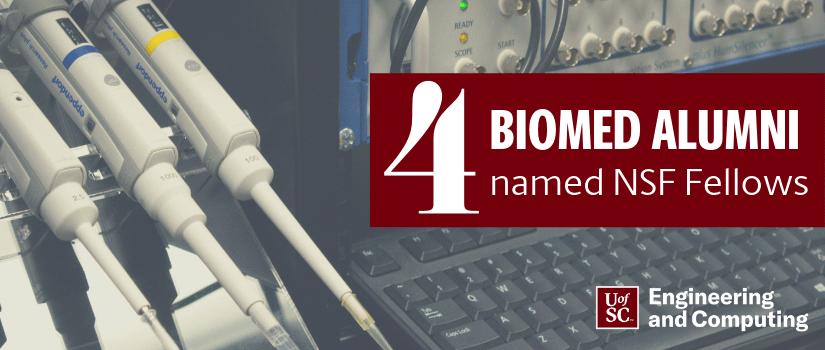By Abe Danaher | April 26, 2019
The College of Engineering and Computing has had four biomedical engineering spring 2018 graduates selected to the National Science Foundation’s 2019 Graduate Research Fellowship Program. The students – Heather Struckman, Shrusti Patel, Colman Moore and Samantha Stewart – are among 2,050 graduate students from institutions across the U.S. awarded for their research excellence. Their selection brings the biomed program’s total number of NSF Fellows to 11.
“We are very proud to have four NSF Fellows this year who received BS degrees from UofSC biomedical engineering,” says Melissa Moss, the director of the biomedical engineering program. “This sets a single-year record for our program, and reflects the strong efforts and success of the biomedical engineering program in providing high-quality, independent research experiences for students interested in research careers.”
The Research Fellowship Program supports U.S. graduate students pursuing research-based master’s and doctoral degrees in science, technology, engineering and mathematics. All fellows receive a three-year annual stipend of $34,000, a cost of education allowance for tuition and fees, and opportunities for international research and professional development. The four UofSC graduates will join the program’s network of more than 50,000 fellows.
Heather Struckman is now a graduate student at The Ohio State University where she studies the role
of nanodomains in cell to cell communication. At UofSC, she conducted undergrad research
in Michael Gower’s lab for four years. Working on two separate projects, she developed tissue engineering
scaffolds for colon cancer treatment, and she isolated and studied foreign body giant
cells from biomaterials implanted into fat tissue.
Shrusti Patel worked in Gower’s lab for a period of time, too, where she studied how left and right
tumors impact macrophage infiltration into the lung. She also researched under Ann Ramsdell, studying the left versus right asymmetric qualities of breasts and how these differences
affect breast development and disease. Currently, she is a graduate student at Vanderbilt developing nanoparticles for RNAi delivery for
breast cancers.
Colman Moore researched in Melissa Moss’ lab, where he researched the ability of isoflavones to inhibit amyloid-β protein aggregation, a process associated with neurodegeneration that occurs during Alzheimer’s disease. He is now a graduate student at the University of California San Diego developing ultrasound-based contrast agents to detect and treat periodontal disease.
Samantha Stewart conducted undergraduate research with Sue Lessner to characterize the biomechanical behavior of atherosclerotic plaques, with a focus on plaque fracture. Her work in Lessner’s laboratory earned her a co-authorship on a publication in Acta Biomaterialia. She is now a graduate student at the University of Maryland developing multi-scale biomaterials with applications in cancer therapy, regenerative medicine and cell banking.
